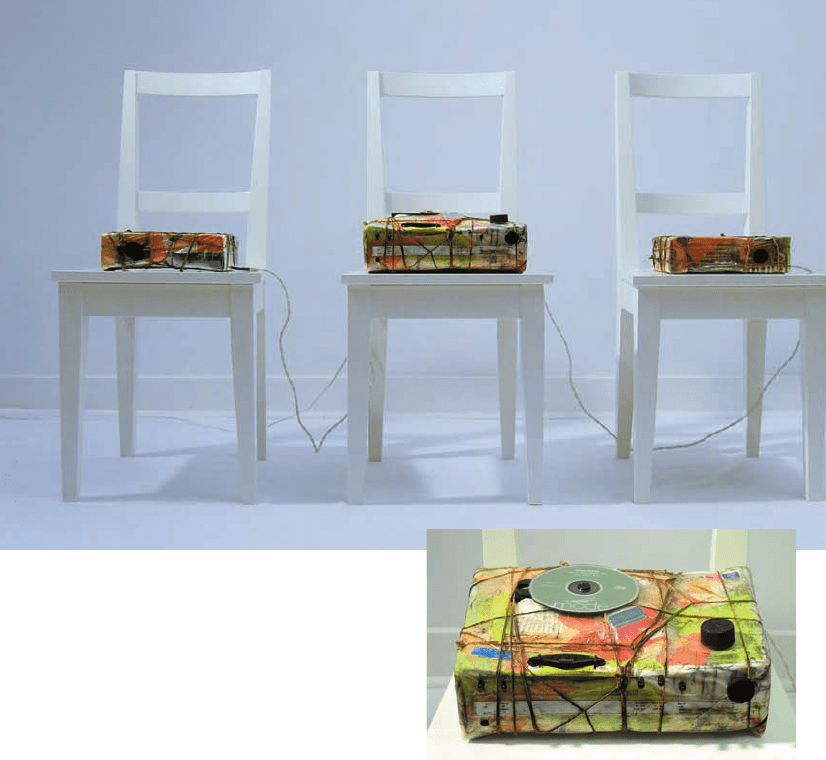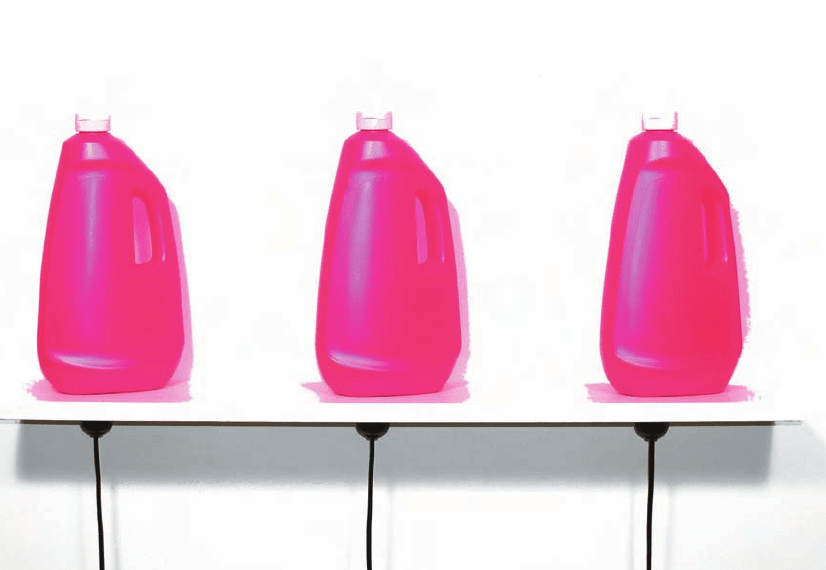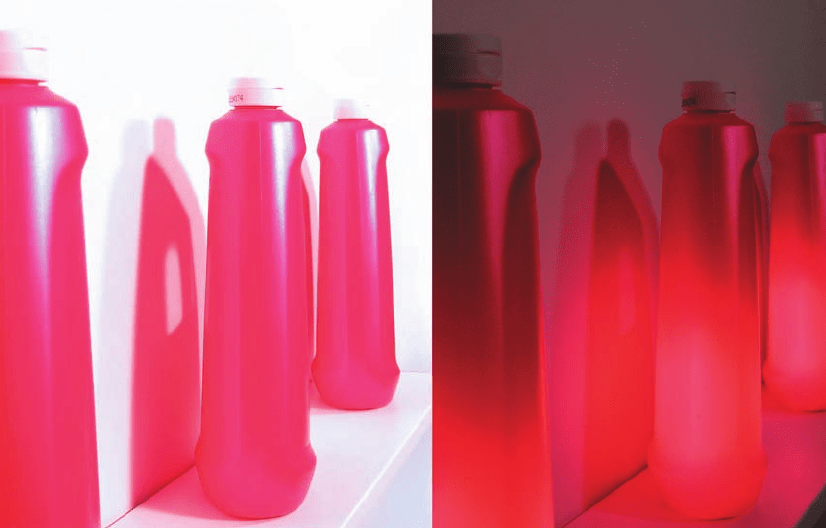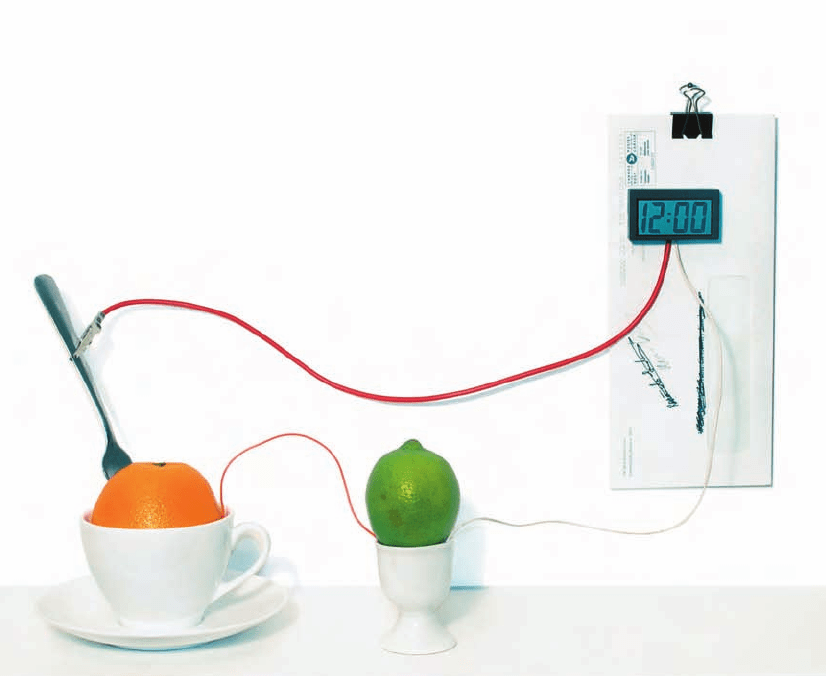Walker S. Sustainable by Design: Explorations in Theory and Practice
Подождите немного. Документ загружается.


Figure 14.4a
CD Player/Radio:
Recovered circuitry, reused
paper products, twine, mosquito
netting, three new chairs
Figure 14.4b
CD Player detail
book.indd 178 4/7/06 12:26:09

Figure 14.4b
CD Player detail
Figure 14.5a
Bottle Lamps:
Standard electrical parts, low-energy
compact fluorescent lamps, reused
soap bottles, modified wooden shelf
book.indd 179 4/7/06 12:26:11

Figure 14.5b
Bottle Lamps detail:
Lamps off and on
book.indd 180 4/7/06 12:26:12
181181
The final design is a digital clock, Figure 14.7, which perhaps best
exemplifies the ephemeral object achieved through an accumulation
of elements. Here, a white shelf again provides the basis for the
composition. A cup and saucer, an eggcup, a discarded envelope, a
bulldog clip and a low-power LCD display are combined to form a
digital clock; fruit is added to provide a natural battery. All the items can
be readily dispersed and reused.
As in previous exercises, the direction explored here implies a shift in the
manufacturing process from centralized mass production to a form that
includes contributions at the local level. It makes use of mass
-produced
elements that can be included in a variety of ‘functional concentrations’,
rather than specialized parts designed for use in just one design. It also
provides an opportunity to include more redesign and re-production
at the local level, enabling possibilities for local employment, culturally
relevant design and promotion of a transformation from a production-
based manufacturing economy to a more balanced, locally involved,
production- and service-based economy. The ‘ephemeral object’
outlined here also begins to integrate the economic benefits of mass
production with socio-economic and environmental responsibilities.
Thus, this kind of approach, and the objects it makes possible, would
appear to be in closer accord with the principles and objectives
of sustainability.
book.indd 181 4/7/06 12:26:13

Figure 14.6
Hanging Lamps:
Standard electrical parts, low-energy
compact fluorescent lamps, tent fabric,
climbing cord, cord spring clips
book.indd 182 4/7/06 12:26:14

183
Figure 14.7
Off-the-Shelf Clock:
LCD, cup and saucer, eggcup,
fork, bulldog clip, reused envelope,
crocodile clip, wire, wooden shelf
book.indd 183 4/7/06 12:26:15
book.indd 184 4/7/06 12:26:15
15
INTELLECTUAL
AND AESTHETIC
UNDERSTANDINGS
OF DESIGN
the
considered
gaze
Theory and practice, two quite different but intimately related aspects
of design, will be explored in this chapter to provide a more complete
basis for the design and critique of sustainable products. I will describe
the relationship between theory and practice and, more particularly,
the relationship between an intellectual understanding of ethics and
the aesthetics of sustainable objects. To demonstrate this relationship, I
consider the aesthetic qualities of one particular design, the digital clock
introduced in Chapter 14 (Figure 14.7).
This chapter is intended to move the discussion from the broad overview
of sustainable product design, which began the book, and the general
design principles and design process of later chapters, to the specific
details of one particular object and their relationship to sustainable
design. This is necessary because an essential aspect of the designer’s
work is the aesthetic definition of an object; and aesthetics are
dependent upon specifics.
Theoretical inquiry is concerned with the development of a system
of ideas to explain something
. It is ‘based on general principles
book.indd 185 4/7/06 12:26:15
Sustainable by Design
186186
independent of the specific thing to be explained’
1
and is progressed
through intellectual activity, that is, through reasoning and objective
understanding. Design practice and aesthetic definition, on the other
hand, require attention to specifics within the holistic development of a
particular product, and not ‘general principles independent of the thing
to be explained’. Critique is an integral part of this designing process,
and is also applied to the final object.
The intellectual and aesthetic issues of design, and their relationship,
provide the basis for creating
, understanding and critiquing products.
In terms of sustainability, the relationship between theory and
practice is such that the ethical and environmental imperatives of the
sustainable rationale can inform the design process and affect the
intrinsic properties of the product. In turn, this will affect one’s aesthetic
experience of the product and suggest a basis for sustainable aesthetics.
I will discuss and illustrate these issues in terms of both the designer’s
intentions and creative aesthetic sensibility, and the user’s a priori
knowledge and the aesthetic experience.
When we set out to design a functional object, a clear understanding
of intentions and a set of design criteria have to be established.
The object will have to function effectively
, it must be designed for a
particular market and manufactured at a certain cost, and it must be
safe, comprehensible and attractive to the intended user. These factors
are established before the design work begins and so they represent a
set of ideas about the object that are extrinsic to any particular design
outcome. In this sense, the design intentions and criteria are based
on general ideas and principles and, as such, they are theoretical or
abstract, they do not have physical or concrete existence. They include a
broad set of assumptions, knowledge and information about the context
of production, the types of materials, forms and assembly techniques
suited to modern mass production and knowledge about similar
products already on the market. These theoretical ideas, intentions and
criteria help define an object in terms of its extrinsic properties. It then
becomes the responsibility of the designer, during the design process,
to create concepts that bring together and attend to these factors, and
this eventually results in a specific design. Hence, while intentions and
design criteria are determined prior to, and independent of, the activity
of designing, they find their resolution in the final design outcome. They
are critical to the designer’s decision making, and influence the way the
final design is established, understood and judged.
book.indd 186 4/7/06 12:26:15
187
Intellectual and Aesthetic Understandings of Design
Designing involves satisfying intentions and criteria in an holistic manner
– and this is usually achieved by generating various design concepts.
These will be developed to meet most or all the criteria and some
will be judged better than others. This creative process, however, is
concerned not with intellectual pursuits but with aesthetic discernment.
The aesthetic sensibility requires attention to the precise properties of
a particular design concept. It calls for sensational acuity, emotional
spontaneity, attentiveness and contemplation, an holistic appreciation
and, during the process of designing, a setting aside of the intellectual
self.
2
It is in the practical process of designing the specific content and
intrinsic properties of an object are made manifest: intrinsic properties
being the base properties fixed within an object which constitute its
essential nature.
3
Thus, the design of a functional object involves theory and practice
and, while each represents a different mode of thinking and a quite
distinct way of engaging with the world, they are, nevertheless,
intimately connected. Some of the extrinsic properties of an object will
be strongly related to its intrinsic properties and, because of this, the
extrinsic properties can have a bearing on one’s aesthetic experience
of the object. As Eaton has made clear, information about intentions
is an integral part of our experience of artefacts, and intellectual
information about an object can be aesthetically relevant if it draws
attention to those intrinsic properties that are relevant to the aesthetic
experience.
4
An example here may be useful. The musical composition
The Freeman Etudes by John Cage is a difficult work to listen to – being
a series of unrelated, independent, randomly generated events for
violin.
5
However, knowing something of the composer’s oeuvre, his
intentions and the method he adopted to compose the piece, enables
the listener to understand the work and appreciate the serious intent
behind its form, which, in turn, can inform and enhance one’s aesthetic
experience. With this clarification of the theoretical and practice-based
aspects of design, and the relationship between the two, we can move
on to consider the link between ethics, aesthetics and
sustainable design.
Design can be understood in terms of the added value it brings to
manufacturers and consumers and the role it plays in the market system
of supply and demand. However
, this economic evaluation provides
only a limited grasp of the meaning of functional objects. It does not
book.indd 187 4/7/06 12:26:15
